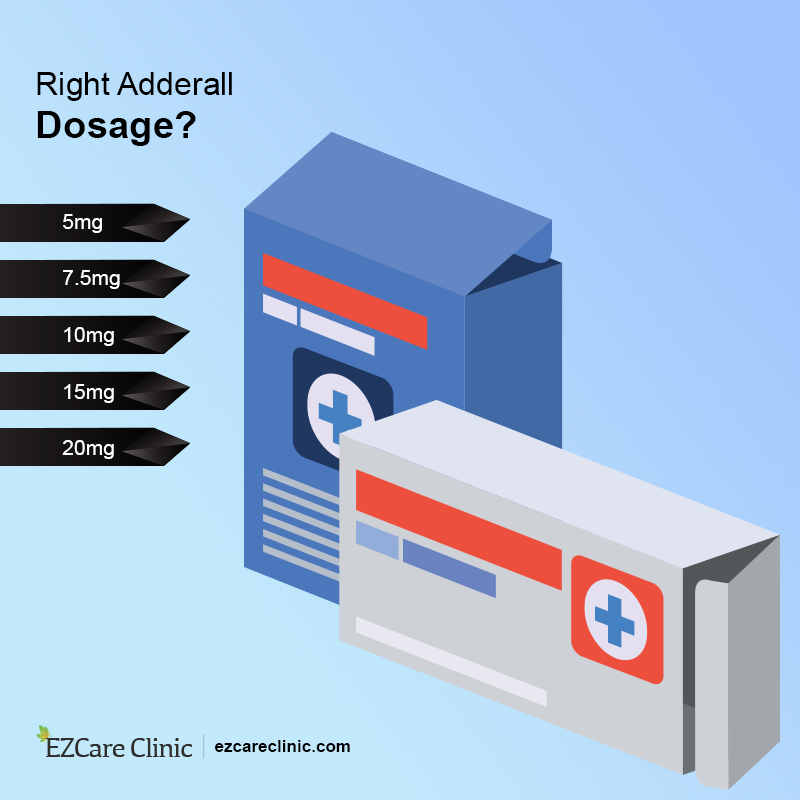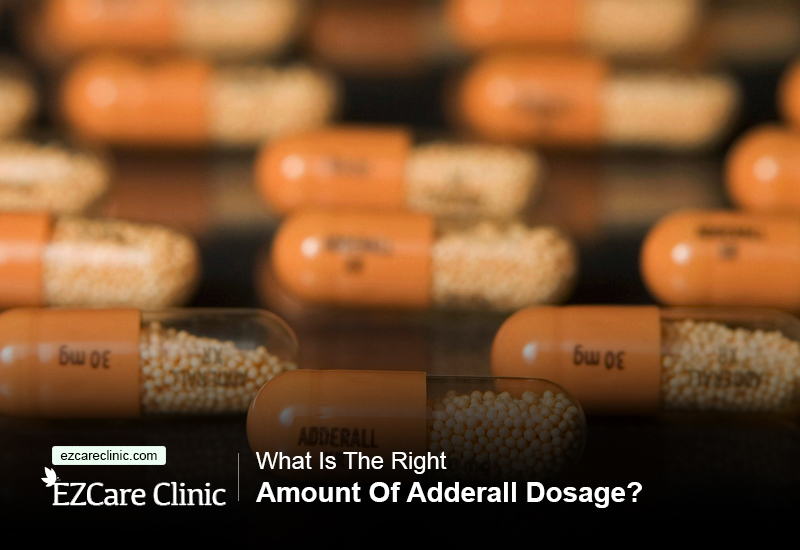Adderall is the brand name of a prescription medication that combines two stimulants: amphetamine and dextroamphetamine sulfate. It is a Schedule II controlled substance commonly prescribed for the treatment of attention deficit hyperactivity disorder (ADHD) in adults. Determining the appropriate dosage of Adderall is crucial to ensure its effectiveness in managing ADHD symptoms while minimizing potential side effects.
This article aims to provide a comprehensive guide to understanding Adderall dosage for adults, including factors that influence dosage determination, Adderall safe dose range, and considerations for optimal treatment outcomes.
Consult an experienced ADHD doctor online. Click below!








What Is Adderall Used For?
Adderall is commonly used to treat ADHD. It can help decrease and manage inattentiveness, hyperactivity, impulsivity, and many other symptoms of ADHD, such as:
- Lack of focus.
- Forgetfulness.
- Hyperactive behavior.
- Fidgeting.
- Disorganization.
- Excessive talking.
- Inability to carry out tasks.
While it’s still not fully understood how Adderall helps treat the disorder, it is believed that it impacts the neurotransmitters in the brain, especially in the area of the prefrontal cortex.
In addition to ADHD management, Adderall can be prescribed to people with narcolepsy. It is another neurological condition that manifests itself in extreme drowsiness and episodes of sudden muscle weakness. Several medications used for ADHD are effective for narcolepsy treatment.
To achieve significant improvement in symptoms, a patient should stick to the right treatment regimen and doctor’s instructions. In the case of Adderall, it includes the correct dosage, aside from other factors.
What Is the Appropriate Adderall Dosage?
As with any medication, the effective dosage of Adderall may vary slightly from patient to patient. It depends on various factors:
- Age is an important consideration when choosing the most appropriate dose of Adderall. The recommended dose can vary in children, adolescents, adults, and the elderly.
- Pre-existing medical conditions such as kidney or liver disease can alter Adderall’s metabolism in the body, and the dose needs to be re-evaluated in such cases.
- Response to treatment is assessed from time to time, and doses are adjusted accordingly to establish a safe and therapeutic dose.
- Medication interactions can increase or decrease the effectiveness of Adderall when used with other medicines. It’s imperative that the medication history of the patient is thoroughly investigated before prescribing Adderall.
- Tolerance to Adderall is possible with prolonged use. Dosage adjustments may be required for the same therapeutic effects.
Many factors influence the dosage of Adderall and a patient’s response. It’s important to consult with a doctor before increasing or decreasing Adderall dosing.
Adderall Dosage for Adults
Adderall treatment is initially started at lower dosages. Based upon patient feedback, medication levels are adjusted for the effective management of ADHD symptoms. The dosage chart for adults using Adderall IR (immediate-release) equally divides doses throughout the day. This administration method ensures rapid release and fast action of the drug while maintaining a steady medication level in the body, thereby optimizing its effects. Adderall dosage for ADHD per the FDA guidelines is not to exceed 40 mg in one 24-hour period. Possible formulations of Adderall IR include:
- 5 mg
- 7.5 mg
- 10 mg
- 12.5
- 15 mg
- 20 mg
- 30 mg
The maximum dosage for adults using Adderall XR (extended-release) is 60 mg in a 24-hour period and in most cases, it’s to be taken only once per day because this formulation provides a prolonged release of the medication:
- 5 mg
- 10 mg
- 15 mg
- 20 mg
- 25 mg
- 30 mg
Immediate-release Adderall typically allows a more flexible dosing schedule than the extended-release formulation. It allows doctors to start with a minimal suggested initial dose and increase it incrementally at weekly intervals if needed. The starting dosage for adults who receive

Dosage Chart for Adderall and Adderall XR
| ADHD | Narcolepsy | |
| Children (6-12 years old) | Initial dose: 5-10 mg once daily in the morning. Standard dose: 10-20 mg once daily or divided into 1-2 doses. Maximum dose: 30 mg once daily or divided into 1-2 doses. | Initial dose: 5 mg once daily in the morning. Standard dose: 5-60 mg once daily or divided into 1-2 doses. Maximum dose: 60 mg once daily or divided into 1-2 doses. |
| Adolescents (13-17 years old) | Initial dose: 10 mg once daily in the morning. Standard dose: 10-20 mg once daily or divided into 1-2 doses. Maximum dose: 20 mg once daily or divided into 1-2 doses. | Initial dose: 10 mg once daily in the morning. Standard dose: 10-60 mg once daily or divided into 1-2 doses. Maximum dose: 60 mg once daily or divided into 1-2 doses. |
| Adults | Initial dose: 10-20 mg once daily in the morning. Standard dose: 20 mg once daily or divided into 1-2 doses. Maximum dose: 40 mg once daily or divided into 1-2 doses. | Initial dose: 10 mg once daily in the morning. Standard dose: 10-60 mg once daily or divided into 1-2 doses. Maximum dose: 60 mg once daily or divided into 1-2 doses. |
Adderall dosage for children can change throughout the treatment course, either up or down over time. After the age of sixteen, the threshold dose usually remains the same during their continued therapy with Adderall. Note that the dosage of Adderall is chosen individually, and a consultation with a healthcare provider is mandatory.
How to Take Adderall
Specific instructions on taking Adderall can be provided by your prescriber after a detailed evaluation of your symptoms. There are also general recommendations that allow patients to take Adderall safely and effectively, ensuring optimal results while minimizing potential risks. These are the following:
- Follow the prescribed dosage. If it’s deemed medically necessary and you get prescribed Adderall, strictly adhere to the dosage instructions provided by your healthcare professional. Dosages vary depending on individual needs, and you should never adjust the Adderall dose without consulting your doctor first. Taking more than the prescribed amount can lead to adverse effects and potential dependence.
- Maintain exact timing and regularity. Establishing a regular schedule and taking the medication at the same time each day helps maintain a steady level of the drug in your system. Follow the instructions provided by your doctor regarding the timing and frequency of your doses. When taking Adderall once daily, it is recommended to take it in the morning about 15-20 minutes after a protein-based breakfast. If you are prescribed Adderall twice daily, it is advisable to avoid late evening dosages to minimize the risk of insomnia.
- Regularly monitor your health. Throughout the duration of Adderall usage, pay attention to any changes in your physical and mental health. If you experience severe side effects, such as chest pain, rapid heartbeat, or mood swings, contact your healthcare professional immediately. Regular check-ups and open communication with your doctor will ensure your well-being and help monitor the effectiveness of the medication.
- Precautions for patients with pre-existing conditions. Individuals with blood pressure issues or any heart problems should avoid taking Adderall, as it can potentially increase the risk of stroke, myocardial infarction, or sudden death. Additionally, individuals with impaired liver or kidney function should inform their doctor prior to taking Adderall. Also, individuals with a past history of substance abuse and who are on suboxone are at a substantially higher risk for a relapse of their addiction and death.
- Do not suddenly stop taking Adderall. Abruptly discontinuing Adderall can lead to withdrawal symptoms and a rebound effect. If your healthcare professional suggests you stop taking Adderall, you’ll be informed about the tapering process. Gradually weaning off the drug is recommended to minimize potential withdrawal effects.
Proper Administration of Adderall
The optimal dosage is only one aspect to consider when taking Adderall for attention deficit hyperactivity disorder. Other factors include the following:
- Food and beverages. Certain foods and beverages can interact negatively with Adderall, affecting its absorption or increasing bothersome adverse reactions. Avoid consuming citric and
ascorbic acid[3] (vitamin C) in supplements, juice, or food, as they can impact the medication’s efficacy. Additionally, caffeine and other stimulants should be limited or avoided to prevent overstimulation. - Balanced diet. While taking Adderall, it’s essential to stay properly hydrated and maintain a well-balanced diet. Amphetamines can decrease appetite, and it’s advisable to consume regular, nutritious meals. Dehydration can amplify side effects such as dry mouth, and drinking plenty of water throughout the day is encouraged.
- Drug interactions. It is crucial to avoid combining Adderall with alcohol, recreational drugs, or other prescription medications without consulting your healthcare professional. Mixing substances can lead to unpredictable interactions, severe side effects, and potentially life-threatening situations. Always disclose any other medications or substances you are taking to your doctor.
- Whole tablets. Adderall tablets should be swallowed whole with water without chewing or crushing them. Crushing the tablets can interfere with the intended release mechanism and alter the drug’s effectiveness. If you have difficulty swallowing pills, discuss alternative options, such as capsules or other formulations, with your doctor.
Regular and open communication with your prescribing doctor is crucial throughout your Adderall treatment. Keep your doctor informed about any negative changes in your mental state or any other adverse side effects. Behavioral symptoms which may be sufficient to alter your mental status is an urgent side effect. Stop Adderall treatment immediately and contact your provider. A doctor can address the side effects, evaluate the effectiveness of the drug, make necessary adjustments to the dosage if required, and address any additional questions or issues you may have.
Click the button below and find out more about the most suitable ADHD treatment option for you.
Adderall Contraindications and Warnings
Although Adderall is one of the most widely used medications for ADHD, it is not appropriate for everyone. There are many contraindications to Adderall use, including:
- Serious cardiovascular issues (recent heart attack, stroke, etc.).
- Advanced narrowing of blood vessels (arteriosclerosis).
- Moderate to severe hypertension.
- Overactive thyroid (hyperthyroidism).
- Raised pressure in the eye (glaucoma).
- End-stage renal disease (ESRD).
- Severe agitation.
- History of drug abuse and addiction.
- Allergy to amphetamine and other Adderall products.
Besides these conditions, Adderall may also cause the following serious health risks:
- Serious cardiovascular reactions in people with structural heart abnormalities and other severe cardiac issues.
- Abnormal increase in blood pressure and heart rate.
- Increased risk of psychiatric events, such as re-appearance of manic symptoms in patients with bipolar disorder.
- Inadequate growth in children.
- Reduced blood circulation to fingers and toes, leading to peripheral vasculopathy, including the Raynaud phenomenon.
- A lower threshold of seizure activity and increased likelihood of convulsions.
- Problems with vision, including blurring of vision and issues with image focusing.
- Increased serotonin levels in the brain when used with other serotonergic drugs which may lead to serotonin syndrome.
- Exacerbation of tics.
Overdose Symptoms and Management
The maximum daily dose of Adderall IR for the treatment of ADHD is 40 mg/day. Exceeding this dosage increases the risk of toxicity and potential overdose. It’s important to note that overdose thresholds vary from person to person. Common symptoms of Adderall overdose include:
- Restlessness
- Tremors
- Convulsions
- Confusion
- Hyperventilation
- High blood pressure
- Palpitations
- Hallucinations
- Panic
- Coma
If you experience any symptoms indicative of an overdose, seek immediate medical help. Prompt action can help prevent further complications.
It is crucial not to take a higher dose than prescribed. If you feel that the current dosage is no longer effectively relieving your symptoms, consult your doctor instead of self-adjusting. A healthcare provider will assess your situation and make any necessary changes to your treatment plan. Additionally, it’s crucial to be cautious when combining Adderall with specific drugs, such as MAOIs, as they can interact in ways that lead to toxicity and can increase the risk of overdose.
Tolerance and Dependence
Adderall contains amphetamine, which is a commonly abused substance. Prolonged usage beyond the prescribed period or higher doses than recommended can lead to the development of tolerance and dependence on the medication. As a result, patients may not experience symptomatic relief even at therapeutic concentrations. It is critical to always follow the guidelines provided by your doctor to ensure safe and effective usage of Adderall.
Important Adderall Medication Interactions
Many medications can interact and interfere with Adderall’s functioning in the body and alter its metabolism:
- Monoamine oxidase inhibitors (MAOIs) are contraindicated with Adderall as they can potentiate the effects of amphetamine, causing hypertensive crisis. Therefore, Adderall should not be used in conjunction with MAOIs or within 14 days after stopping them.
- Serotonergic drugs such as selective serotonin inhibitors (SSRIs) increase serotonin levels in the brain, and their use with Adderall can lead to serotonin syndrome. Signs of raised serotonin can include restlessness, insomnia, confusion, rapid heartbeat, muscle rigidity, and high blood pressure, among others.
- Alkalinizing agents such as thiazide can increase the effects of amphetamine.
- Acidifying agents such as ascorbic acid can decrease the effectiveness of amphetamine.
- Proton pump inhibitors such as omeprazole can decrease the time for amphetamine to reach maximum plasma concentration.
These medications and several others can disrupt Adderall’s efficacy and in many cases, a dosage adjustment may be warranted. Therefore, it is critical to discuss your medication history in detail with a healthcare professional before starting Adderall.
Adderall Discontinuation
It is important to avoid abruptly discontinuing Adderall or switching to another medication without proper guidance. Doing so can lead to severe withdrawal side effects. These side effects can vary in severity and may include:
- Fatigue.
- Depression.
- Irritability.
- Mood swings.
- Insomnia.
- An overall sense of discomfort.
Always follow your doctor’s instructions, as they will typically recommend a gradual reduction of dosage over a predetermined period of time, a process known as tapering. Tapering allows the body and mind to adjust gradually, minimizing the potential withdrawal effects. By following this approach, you can ensure a smoother transition and minimize any discomfort during the discontinuation process.

Dosage of Adderall vs Other ADHD Medications
Various medications are available to manage the symptoms of attention deficit hyperactivity disorder, each with its own unique characteristics and dosing guidelines.
- Focalin (dexmethylphenidate) is a central nervous system stimulant that primarily consists of dexmethylphenidate hydrochloride. This medication is available in both immediate-release and extended-release formulations. The recommended dosage range for Focalin in children and adolescents is typically 2.5 to 20 mg per day, divided into two doses. For adults, the dosage range may be similar or slightly higher, with a starting dose of 5 mg up to 20 mg per day, divided into two daily doses.
- Concerta (methylphenidate) is an extended-release formulation of stimulant methylphenidate. It provides gradual and sustained release of the medication throughout the day. The dosage of Concerta is determined based on the individual’s needs and can vary from 18 mg to 72 mg per day. Typically, Concerta is taken once daily in the morning.
- Ritalin (methylphenidate) is a CNS stimulant medication containing methylphenidate often used as a short-acting medication to manage ADHD symptoms. It is available in immediate-release, sustained-release, and extended-release formulations. The dosage range for Ritalin varies depending on the formulation (tablet or liquid) and the individual’s age. For children and adolescents, the daily dosage usually ranges from 5 mg to 60 mg, in divided doses. The average dosage for adults is usually 20 mg to 30 mg per day, divided into 2-3 doses. In some cases, adults may require higher doses, up to a maximum of 60 mg per day.
- Vyvanse (lisdexamfetamine dimesylate) is a prodrug that is converted into dextroamphetamine in the body. It is available in capsule or tablet form with various dosage strengths. The recommended starting therapeutic dose for children is 30 mg once daily, which can be increased gradually if necessary. For adults, the typical dosage range is 30 mg to 70 mg per day.
- Dexedrine (amphetamine) is a central nervous system stimulant medication that increases the levels of certain neurotransmitters in the brain. For children aged 6 and older and adults, the initial dose is typically 5 mg once or twice daily, with the maximum dosage reaching 40 mg per day.
- Adzenys XR-ODT (amphetamine) is an amphetamine-based stimulant medication available as orally disintegrating tablets in extended-release formulations for ADHD. It increases the levels of dopamine and norepinephrine in the brain. The recommended dose in children and adolescents between 6 to 17 years old is 6.3 mg daily. For adults, the daily recommended dose is 12.5 mg taken in the morning.
- Mydayis (amphetamine mixed salts) is a central nervous system stimulant that works in a similar way to Adderall by increasing the levels of neurotransmitters in the brain. It is approved for ADHD treatment in adults and children 13 years and older. The recommended starting dose in pediatric patients is 12.5 mg daily which can be increased to 25 mg daily. Whereas in adults, the starting daily dose is the same (25 mg), and the maximum dose can be increased up to 50 mg daily.
- Strattera (atomoxetine) is a non-stimulant medication approved for the treatment of attention deficit hyperactivity disorder. Unlike stimulant drugs, it does not have a controlled substance classification. The recommended starting dose for children and adolescents is usually 0.5 mg/kg once daily, which can be increased gradually with the average daily dose being 1.2mg/day. For adults, the initial dosage is often 40 mg once daily, which can also be adjusted based on individual patient response. The maximum daily dose is 100 mg.
- Kapvay (clonidine) is an alpha-2 adrenergic agonist that is prescribed for ADHD, especially for managing hyperactivity and impulsivity. It is typically used as an adjunctive or alternative treatment when stimulant medications are not suitable. For adults, the starting dose is typically 0.1 mg twice daily, with a maximum dosage of 0.4 mg per day.
- Intuniv (guanfacine) is a non-stimulant medication commonly used as an adjunctive treatment for attention deficit hyperactivity disorder. Its active ingredient is guanfacine, another alpha-2 adrenergic agonist that helps regulate certain brain functions. The recommended starting dose is usually 1 mg once daily, which can be increased gradually if necessary. The maximum dosage is 4 mg per day.
- Qelbree (viloxazine hydrochloride) is a newly approved non-stimulant medication for ADHD. It increases the levels of norepinephrine in the brain, which is believed to be its mechanism for controlling ADHD symptoms. The recommended starting dose for children between 6 and 11 years is 100 mg daily, which can be increased to a maximum of 400 mg daily in weekly intervals. For pediatric patients between 12 and 17 years and adults, the recommended starting dose is 200 mg daily. In adults, the dose can be increased up to 600 mg daily for symptom control.
Factors Influencing Dosage When Switching From Adderall
As Adderall is not suitable for everyone and can also cause various side effects, doctors may recommend switching to another medication for ADHD management. Several things are taken into consideration when changing to an alternative medication:
- Pharmacological aspects such as the mechanism of action, duration of action, bioavailability, etc. of different ADHD drugs vary. It should be taken into consideration for dosage calculation when switching from Adderall to another medication.
- Patient responses to the new medication may not be the same as expected. The goal is to find the most effective dose by careful monitoring and dosage adjustment depending on the patient’s feedback.
- Cross-tolerance may develop to other stimulant medications as well due to prolonged use of Adderall, which can be a key determinant in selecting the dosage of the new medication.
- Safety profiles of the drugs are reviewed before determining the new medication dosage as there may be an increased risk of specific side effects.
All these and other factors can be pivotal in determining the dosage of the alternative medication.
Key Takeaways
Adderall is among the most commonly prescribed medications for ADHD, but its use has to be tailored to individual needs. Different patients receive different instructions on Adderall use, and any decision on the dosing should be first discussed with a healthcare provider.
From diagnosis and full-scale treatment, EZCare Clinic offers comprehensive care for adults having ADHD. Determining how the disorder impacts your life and what symptoms require immediate attention is the first step in choosing the right treatment plan. Our medical staff can provide you with holistic care, including prescriptions for stimulant or non-stimulant medications or other treatment options.
FAQ
How to manage missed Adderall doses?
To manage a missed Adderall dosage, take the missed dose as soon as you remember. Avoid doubling up on doses if it’s already time for your next dose to ensure a safe dose range. Avoid the missed dose if you are within 6-10 hours of bedtime. Follow your dosing instructions and maintain a consistent schedule. If you have concerns or frequently miss doses, consult your healthcare provider.
What is the maximum duration of an Adderall prescription, and how can it be renewed?
Typically, Adderall prescriptions are initially prescribed for 30 days. To obtain a new prescription, you would need to schedule an appointment with your healthcare provider. During the appointment, they will assess your current condition, review the effectiveness of the medication, and determine whether it is appropriate to continue the prescription.
How do I know if I have taken an excessive amount of Adderall?
Signs of taking an excessive amount of Adderall may include severe restlessness, tremors, rapid breathing, elevated heart rate, chest pain, extreme agitation, confusion, hallucinations, or panic attacks. If you experience any of these symptoms, seek medical help immediately.
Is it safe to take 20 mg of Adderall twice daily?
40 mg daily is the maximum Adderall IR dosage for adults with ADHD. The safest Adderall dosage will be determined by a healthcare professional based on individual needs and medical history. It is essential to follow the prescribed dosage instructions and consult with your healthcare provider before making any changes to your medication regimen to avoid Adderall misuse and overdose.
How to establish an effective Adderall routine?
To establish an effective Adderall routine, follow these guidelines:
- Follow the prescribed dosage. Take Adderall exactly as prescribed by your doctor. Do not exceed the recommended dosage or change the timing without consulting your healthcare professional.
- Establish a consistent schedule. Take Adderall at the same time each day to maintain a regular routine. This helps optimize its effectiveness and reduces the risk of forgetting a dose.
- Monitor your response. Pay attention to how Adderall affects you. Note any changes in your focus, attention, and overall well-being. Keep a record of any side effects or concerns and discuss them with your doctor.
- Avoid late-day doses. Adderall can interfere with sleep. To minimize this effect, it’s generally recommended to avoid taking Adderall late in the day to allow for a restful night’s sleep.
- Pay attention to healthy lifestyle habits. Adderall is most effective when complemented by a healthy lifestyle. Engage in regular exercise, maintain a balanced diet, manage stress, and prioritize quality sleep.
- Regularly follow up with your doctor. Schedule regular follow-up appointments to assess the effectiveness of your Adderall routine. A doctor can make any necessary adjustments or provide alternative treatments if needed.
How to take Adderall effectively?
When taking Adderall, it is crucial to follow the prescribed dosage and administration guidelines provided by your healthcare professional. Take the medication at the same time each day to establish a consistent routine and minimize the risk of missed doses. Also, communicate regularly with your doctor to evaluate the effectiveness of the medication and discuss any potential adjustments to optimize its benefits.
How long does Adderall affect the body?
The duration of Adderall’s effects on the body can vary depending on several factors, including dosage, formulation (immediate-release or extended-release), and the individual’s metabolism. Generally, the immediate-release formulation of Adderall lasts around 4 to 6 hours, while the extended-release version can last up to 12 hours. Consult with a healthcare professional to determine the specific duration of Adderall’s effects based on your circumstances.
Sources
- Treatment - Narcolepsy
Source link - New developments in the management of narcolepsy. (2017)
Source link - Ascorbic Acid
Source link







